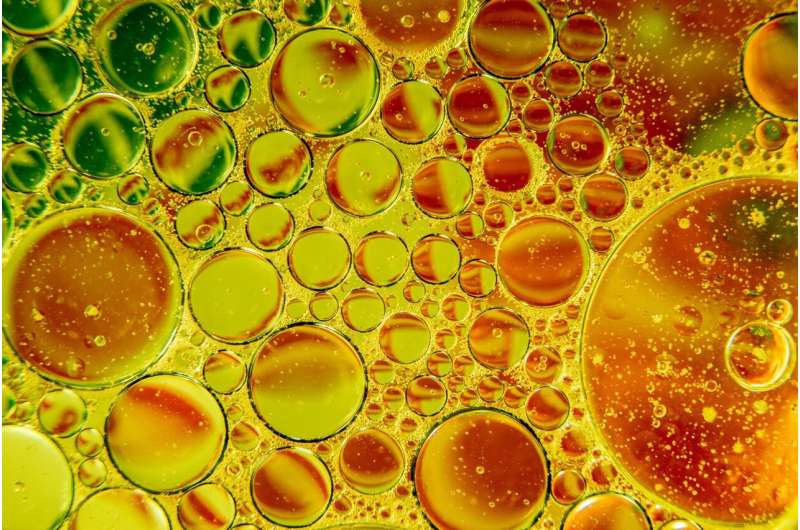August 25, 2022 report
Studying phase separation in liquids at microscopic level when energy is added

Bob Yirka
news contributor

A team of physicists at the University of California at Santa Barbara has discovered some of the dynamics involved with active liquid surfaces at the microscopic level when energy is added. In their paper published in the journal Science, the group describes using high-speed cameras to capture the action as they activated mixed liquids by adding an energy source. Jérémie Palacci with the Institute of Science and Technology Austria has published a Perspective piece in the same journal issue outlining the importance of their work.
As Palacci notes, when some liquids are mixed, such as alcohol and fruit juice, they remain mixed. And when others are mixed, such as oil and vinegar, they soon separate until some sort of energy source (such as shaking) forces them back together. In this new effort, the researchers noted that little work has been done investigating the properties of liquids as they mix (or unmix) at the micro-level and set themselves the task of learning more.
The work involved placing two types of liquids together and studying how they behaved when forced together. More specifically, they combined poly(ethylene glycol) also known as PEG, with dextran, which is a sucrose extract. When mixed in typical settings, the two separate, but not like oil and vinegar: Instead, droplets of PEG form which hover or float in the dextran. The researchers chose the two liquids because they both have very low surface tensions which makes studying how they respond to one another easier. In experiments with the two liquids, the researchers also sometimes added kinesin, a protein that helped the two liquids bind to one another.
To learn more about the behavior of the two liquids when an energy source was added (shaking) the researchers placed them in microtubules—doing so allowed them to see what was happening more clearly.
The researchers observed that shaking created chaotic flows. In mixtures without the addition of kinesin, the droplets formed slowly—adding kinesin speeded up the process. And when they added a lot of kinesin, the droplets became animated, continuously merging and then coming apart again. The researchers noted that, at the interface between the liquids, they could see undulating waves without the need for a microscope. They also found that the liquid mixture became so animated at times that it actually climbed the walls of the microtubules a little bit.
The researchers suggest that there are characteristics of combined liquids that are still unknown and that continued study could lead to a better understanding of fluid applications.
Written for you by our author —this article is the result of careful human work. We rely on readers like you to keep independent science journalism alive. If this reporting matters to you, please consider a (especially monthly). You'll get an ad-free account as a thank-you.
More information: Raymond Adkins et al, Dynamics of active liquid interfaces, Science (2022).
Jérémie Palacci, A soft active matter that can climb walls, Science (2022).
Journal information: Science
© 2022 Science X Network




















